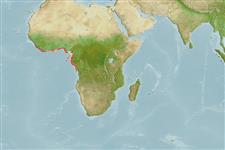>
Gadiformes (Cods) >
Moridae (Morid cods)
Etymology: Laemonema: Greek, laimos = throat + Greek, nema = filament (Ref. 45335).
More on author: Poll.
Environment: milieu / climate zone / depth range / distribution range
นิเวศวิทยา
เกี่ยวกับทะเล,น้ำเค็ม สัตว์หน้าดินในเขตน้ำลึก; ระดับความลึก 200 - 618 m (Ref. 31160), usually 300 - ? m (Ref. 1371). Deep-water; 8°N - 8°S, 13°W - 12°E (Ref. 1371)
Eastern Atlantic: in tropical waters.
ขนาด / น้ำหนัก / Age
Maturity: Lm ? range ? - ? cm
Max length : 38.0 cm TL เพศผู้/กระเทย; (Ref. 89108)
เงี่ยงครีบหลัง (รวม) : 0; เงี่ยงครีบก้น: 0; ก้านครีบอ่อนที่ก้น: 60 - 66. Eye large, its diameter greater than snout length. First dorsal fin with moderately elongated filament; pectoral fins reaching to rear level or anal fin origin. Color is generally light brown, lighter ventrally (Ref. 1371). Body elongated; rather slender. Head slightly compressed; mouth large and broad. Lateral line is conspicuous, anteriorly slightly curved upward (Ref. 45854). Also Ref. 6606.
Most abundant around 300 m over soft bottom (Ref. 1371). Minimum depth reported from Ref. 26999.
Life cycle and mating behavior
Maturities | การสืบพันธุ์ | Spawnings | Egg(s) | Fecundities | ตัวอ่อน
Cohen, D.M., T. Inada, T. Iwamoto and N. Scialabba, 1990. FAO species catalogue. Vol. 10. Gadiform fishes of the world (Order Gadiformes). An annotated and illustrated catalogue of cods, hakes, grenadiers and other gadiform fishes known to date. FAO Fish. Synop. 125(10). Rome: FAO. 442 p. (Ref. 1371)
IUCN Red List Status (Ref. 130435)
Threat to humans
Harmless
Human uses
การประมง: ไม่มีผลประโยชน์
เครื่องมือ
Special reports
Download XML
แหล่งที่มาจากอินเตอร์เน็ต
Estimates based on models
Preferred temperature (Ref.
123201): 8.7 - 11, mean 8.8 °C (based on 11 cells).
Phylogenetic diversity index (Ref.
82804): PD
50 = 0.5000 [Uniqueness, from 0.5 = low to 2.0 = high].
Bayesian length-weight: a=0.00447 (0.00278 - 0.00717), b=3.14 (3.00 - 3.28), in cm total length, based on LWR estimates for this species & (Sub)family-body (Ref.
93245).
ระดับชั้นอาหาร (Ref.
69278): 3.5 ±0.50 se; based on food items.
ความสามารถในการกลับคืนสู่ปกติ (Ref.
120179): ขนาดกลาง, เวลาต่ำสุดที่จะทำให้ประชากรเพิ่มขึ้นเป็น 2 เท่าใช้เวลา 1.4 - 4.4 ปี (Assuming tmax>3).
Fishing Vulnerability (Ref.
59153): Low to moderate vulnerability (28 of 100).
